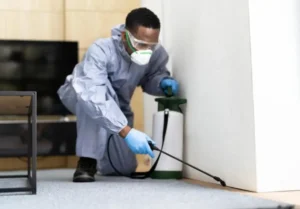Your home is your sanctuary where family members should feel safe and comfortable. Pests threaten that security by spreading diseases, causing property damage, and creating stress. Norfolk’s coastal climate supports year-round pest activity that requires vigilant protection to maintain healthy living environments.
Health Risks Associated with Common Household Pests
Cockroaches carry numerous pathogens that cause serious illnesses. They pick up bacteria from sewers, garbage, and decaying matter, then spread these contaminants across kitchen counters, dishes, and food storage areas. Salmonella, E. coli, and other food-borne pathogens transfer easily from roach bodies to human food sources.
Allergens from cockroach droppings, shed skins, and saliva trigger asthma attacks and allergic reactions. Children exposed to cockroach allergens during early development show higher rates of asthma diagnosis. Symptoms include coughing, wheezing, chest tightness, and difficulty breathing.
Rodent droppings and urine spread hantavirus, leptospirosis, and other dangerous diseases. Dried droppings crumble into dust that becomes airborne, allowing inhalation of contaminated particles. Direct contact with rodent waste or contaminated surfaces transmits diseases through cuts or mucous membranes.
Mosquitoes transmit West Nile virus, Zika virus, and other illnesses through bites. While most infections cause mild symptoms, some result in serious neurological complications. Pregnant women face additional risks from certain mosquito-borne diseases that affect fetal development.
Ticks carry Lyme disease and Rocky Mountain spotted fever. These parasites attach to people and pets during outdoor activities, feeding for hours or days before detection. Early symptoms often go unrecognized, allowing diseases to progress to more serious stages requiring intensive treatment.
Stinging insects cause allergic reactions ranging from local swelling to life-threatening anaphylaxis. People with known allergies face serious risks when wasps, hornets, or yellow jackets nest near homes. Even individuals without previous allergies can develop sensitivities after multiple stings.
Property Damage from Pest Activity
Termites silently consume wooden structures, causing billions in damage nationally each year. Norfolk’s climate supports active termite colonies that work continuously, hollowing out support beams, floor joists, and wall studs. Damage often remains hidden until structural failures occur or renovations expose weakened wood.
Carpenter ants excavate galleries in wood to create nesting spaces. Unlike termites, they do not eat wood but remove it to expand their colonies. Their activity weakens structural members over time, compromising building integrity.
Rodents gnaw constantly to keep their continuously growing teeth manageable. They chew through electrical wiring, creating fire hazards. Insurance companies report thousands of house fires annually caused by rodent-damaged wiring. Rodents also damage insulation, ductwork, and personal belongings stored in attics and crawl spaces.
Powder post beetles infest hardwood floors, furniture, and structural timbers. Adult beetles bore out of wood, leaving small exit holes and piles of fine sawdust. Extensive infestations require fumigation or replacement of damaged wood.
Protecting Children & Pets
Young children spend considerable time on floors where they encounter pest droppings, shed skins, and other contamination. Their developing immune systems prove more susceptible to diseases spread by pests. Toddlers frequently put objects in their mouths, increasing exposure risks.
Pets suffer from flea infestations that cause intense itching, skin infections, and allergic reactions. Heavy flea populations drain blood from small dogs and cats, causing anemia. Fleas also transmit tapeworms and other parasites to pets.
Bed bugs bite children and pets as readily as adults, causing itchy welts and sleep disturbances. The psychological stress of bed bug infestations affects entire families, particularly children who may fear bedtime or develop anxiety about insects.
Curiosity leads children to investigate pest control products stored improperly. Professional services use products and application methods that minimize exposure risks while maximizing effectiveness. Technicians know proper placement techniques that keep treatments away from areas where children and pets frequent.
Preventing Pest Entry into Homes
Exterior maintenance creates the first line of defense against pest invasions. Trimming vegetation away from foundations eliminates bridges that insects and rodents use to access buildings. Removing leaf litter, mulch piles, and yard debris reduces pest harborage near homes.
Foundation inspections identify cracks and gaps requiring sealing. Even small openings allow mice, insects, and other pests to enter. Expanding foam, caulk, and copper mesh fill different types of gaps effectively based on location and size.
Proper drainage around foundations prevents moisture accumulation that attracts pests. Grading soil away from buildings and maintaining functional gutters keeps water moving away from structures. Addressing standing water eliminates mosquito breeding sites and reduces conditions favorable to many pest species.
Attic and crawl space ventilation reduces humidity that attracts pests. Properly functioning vents allow air circulation that creates drier conditions. Installing vapor barriers in crawl spaces further controls moisture levels.
Seasonal Pest Pressures in Norfolk
Spring brings increased ant activity as colonies expand and new queens establish nests. Termite swarms emerge during warm, humid days, seeking locations to start new colonies. Mosquito populations begin building as temperatures rise and rainfall creates breeding sites.
Summer heat drives pests indoors seeking water and cooler temperatures. Roaches become more active, and rodents seek shelter from extreme heat. Stinging insects build nests that grow throughout the season, creating larger populations and increased sting risks.
Fall triggers rodent invasions as mice and rats seek winter shelter. Overwintering pests like stink bugs and lady beetles cluster on sunny exterior walls before finding entry points. Spider activity peaks as adults mature and mate.
Winter provides little relief in Norfolk’s mild climate. Many pests remain active year-round, continuing to breed and feed inside heated structures. Reduced outdoor activity concentrates pest populations in buildings where temperatures support survival.
Benefits of Regular Residential Pest Control
Scheduled service visits catch problems early before infestations establish. Regular inspections identify conducive conditions and emerging pest activity. Small problems addressed immediately never develop into costly, stressful situations.
Preventive treatments create barriers that stop pests before they enter homes. Perimeter applications around foundations prevent exterior pests from finding entry points. Interior treatments address any pests that breach exterior defenses.
Documentation provided by pest control services proves valuable for real estate transactions. Home buyers and sellers benefit from records showing regular pest management and termite inspections. This documentation protects property values and facilitates smooth sales.
Peace of mind allows families to enjoy their homes without worrying about pest encounters. Knowing that professionals monitor your property and address issues promptly reduces stress and improves quality of life.
Conclusion
Residential pest control in Norfolk protects what matters most – your family’s health and your home’s value. Professional services provide expertise, specialized products, and regular monitoring that homeowners cannot duplicate with DIY efforts. Investing in pest control creates safe, comfortable living environments where families thrive without pest-related concerns.



